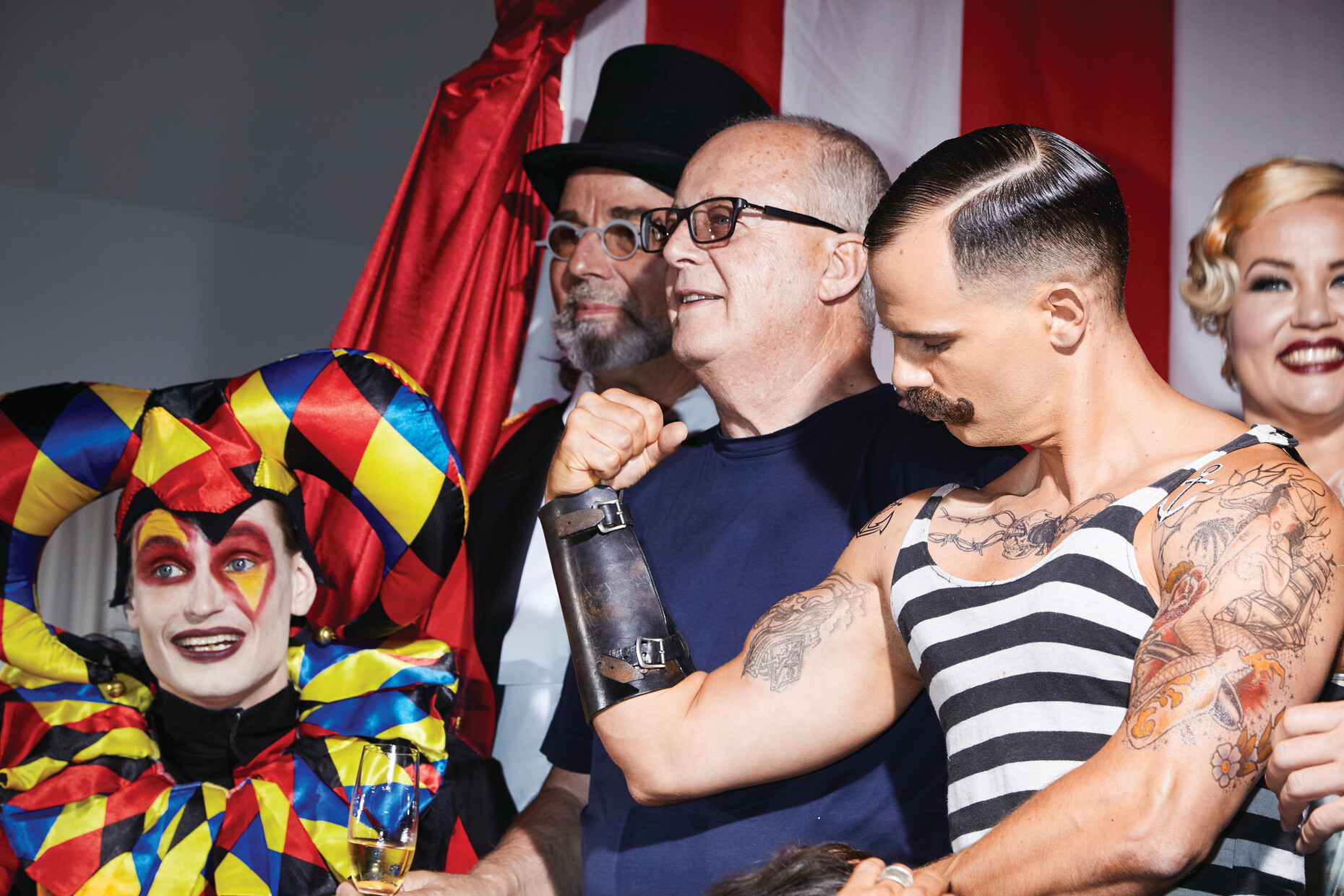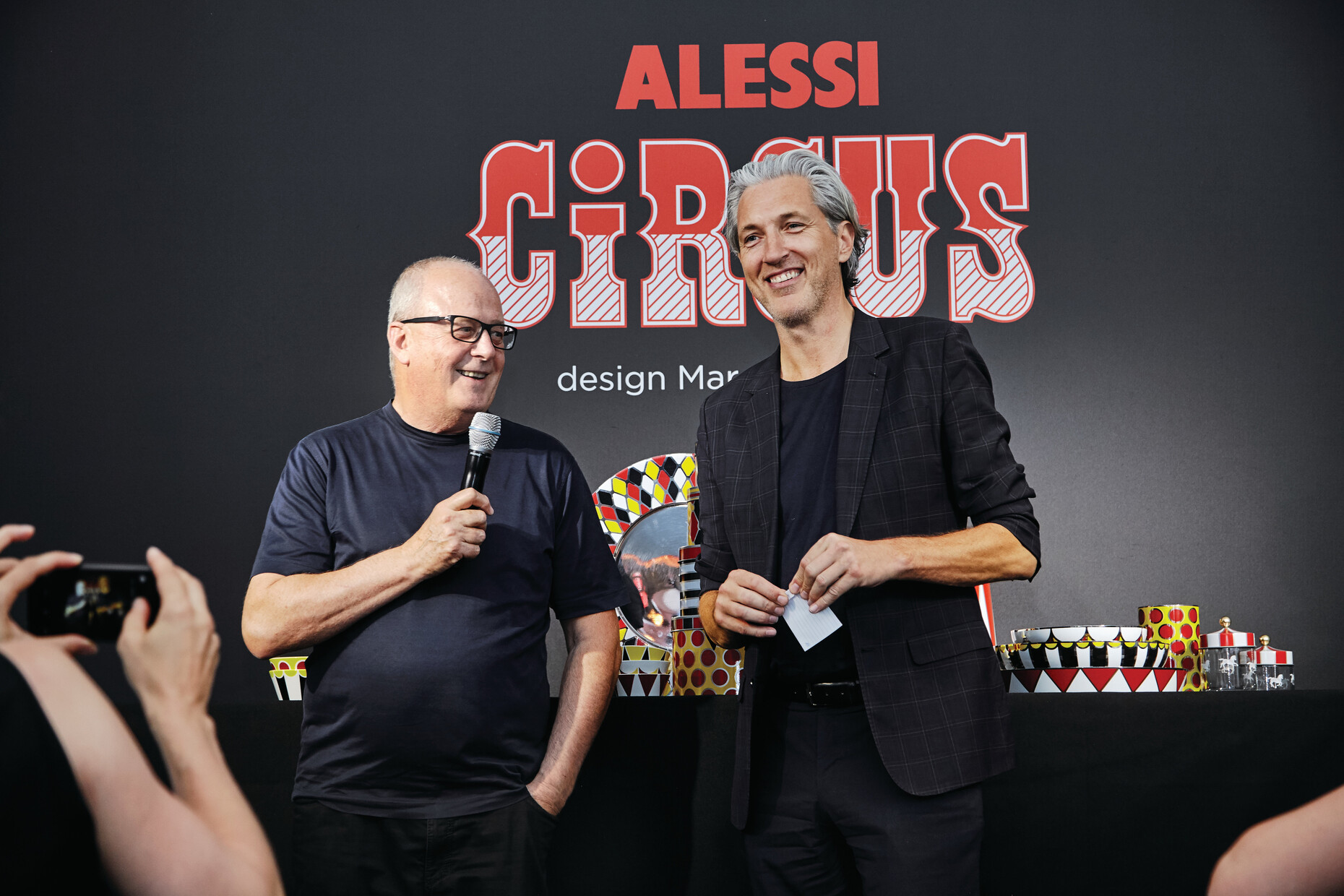In Conversation: Alberto Alessi
The Ringmaster and his Circus
There surely can be no more perfect place to convey a sense of Amsterdam’s quintessence to a visitor: Designer Marcel Wanders’ studio is located in the middle of one of the city’s prettiest and perhaps still most typical quarters, Jordaan, on the top story of an old school. From his terrace, the gaze sweeps over the famous ring of canals, the Herengracht, Keizersgracht and Prinsengracht. It seems you could almost reach out and touch the tall tower of the Westerkerk, and the dome of the Royal Palace is also visible. Yet it is not to celebrate the beauty of the Dutch capital that Wanders and Alessi, the household goods manufacturer from Italy’s Piedmont region, have invited guests. Rather they wish to present the new “Circus” Collection the designer has created for the Italian brand. In Wanders’ studio too, actors dressed as circus figures are flitting around: a ringmaster, a harlequin, a strongman. All the while, the flock of guests inspect the five stainless-steel figures that make up the core of the new collection – as though they were there: a ringmaster, a harlequin, a strongman.
Marcel Wanders has melded five characters from the circus with five everyday objects; the results are as naïve as they are artificial. The figures seem to have come straight out of a children’s book. Some of them tell short stories: The ringmaster, which is actually a table bell, travels around on a little cart pulled by a monkey. The animal is lured by an ever unattainable banana hanging in front of its nose. Another piece has an elephant in a tutu, balancing on one leg on a ball atop a circular music box and holding a small umbrella, while a mouse looks on with curiosity
Whether these objects are considered charming or tacky is surely down to individual taste. They are certainly not for purists. In any case, the chances of actually buying one or more of the figures are few and far between, as only a limited number is being produced and the price tag is steep. Alessi is selling a thousand of each, each costing a thousand euros.The other designs in the “Circus” Collection are intended for a wider range of customers. These include plates, bottle coolers and storage jars, among other items. For the series Marcel Wanders designed various geometric patterns in strong red and yellow colors, as well as black and white. The lidded glass jars with carousel motif are particularly attractive: Whereas the horses are printed onto the glass, the lid is shaped like the roof of a tent, topped by a golden ball.It is without doubt this loveable playfulness that company boss Alberto Alessi refers to when he talks of the typically Dutch feel he likes so much about Marcel Wanders’ design.
Fabian Peters: How did the idea surface for a circus-themed collection?
Alberto Alessi: The first time we started talking about the possibility of doing something like that was about five years ago. Then for a few years we concentrated mainly on other areas, the table service, porcelain, glasses, cutlery, service trays as well as kitchen products, pots and pans. Then two and a half years ago Marcel had the time to think again about a generation of more complicated, more complex products and Marcel was so interested in it we just told him to go for it.
So Marcel Wanders came up with the idea of a circus collection?
Alberto Alessi: He came up with the idea of the circus. That is part of the job of a designer. I do a lot of other things (laughs).
And what did you think when you heard about his idea to make a circus collection?
Alberto Alessi: I liked the idea. I thought it was very much Marcel Wanders, very Dutch, within the Dutch design culture, so I thought it was very good for the Alessi catalog. Me, I had no doubt. The only problem was the question whether Alessi would be able to manufacture these very strange products, because they deviate from the normal industry logic. So I started to work on the project, to understand whether we were able to actually realize it; not just to make one prototype, but to go into production.
There have been a lot of strong characters in previous Alessi collections – like Anna G and Gino Zucchini. Did you ask Marcel Wanders to do something similar?
Alberto Alessi: Not at all. You see, to give you an idea: When we start working with a designer the first thing I do is open a book, the Alessi book, and I ask you to read it. If you feel interested in reading the book then you know that you may try to write one chapter. It’s for you. If you are able to write it, we can publish it. We want to publish it. It is up to you to feel if you have a response to the book: good reactions, strong reactions or maybe a very low response. In that case it is better to leave it as it is and close the book. I always say, you have to feel that you would like to write the book. But then the content of your chapter is mainly down to you.
Do you think that Marcel Wanders was inspired by Alessi’s history?
Alberto Alessi: Certainly. Alessi has a very old tradition of good design, let’s say more serious design. Then during the 1990s, when Marcel Wanders started out, Alessi became well known for more playful, plastic colored products. He thought that he might be able to reinterpret these, create a new face for Alessi’s development by realizing the Circus Collection.
Why did you decide to sell the five circus figures only as a limited collector’s edition, a quite highly priced collector’s edition?
Alberto Alessi: The high price has nothing to do with the limited edition. It’s only because the production costs are very high. Given that the production costs were at the same high level for 1,000 and for 10,000 pieces, we decided to create more value added by limiting the series. The price would not change even if they were not limited.
In my opinion the collection could be considered design at second glance. It doesn’t look as thoroughly designed as a lot of products Alessi has done before. It’s a little bit naïve – in a positive way. It’s a little like it could be from a children’s book. Was that the intention?
Alberto Alessi: That is part of Marcel’s poetics. He has a very strong decorative approach, which is by the way typical of his generation of Dutch designers. And so it was very natural to him and I see it as a good example of contemporary Dutch design, given that Dutch design is very decorative, very expressive and shrill. If you take British designers it’s another story, but it’s important for a company like Alessi to give designers freedom to express their own culture. I wanted his work to be obviously Dutch, as when I work with Jasper Morrison I like that people understand he is British.
(The corkscrew shaped like a Harlequin is placed on the table)
I love this piece so much. It’s such a funny idea to shape it that way. It’s like a jack-in-the-box. I wonder though: Will anybody use it, because it’s a collector’s item.
Alberto Alessi: I believe if you are opening a bottle of Romanée-Conti or Château Lafite...
That would be the right occasion to use it.
Alberto Alessi: The kind of users for the five limited [figures] will probably – no, will surely – be a slightly different kind of customer, not the average Alessi customer – just because of the price, of course.
But they’re not sold out yet?
Alberto Alessi: No, the collection was presented for the first time yesterday evening.
When do you think they will be sold out?
Alberto Alessi: I don’t know. There is also the option for collectors to buy them on the Alessi website. This is a new experience for us. We’ve had some limited editions in the past, but very few. It’ll be a surprise, how long it will take.
Maybe you can say something about the challenges of engineering this collection.
Alberto Alessi: One of the more interesting things was the carillon, the elephant. This carillon is made in Switzerland, in the small city of La-Chaux-de-Fonds, where there is a company which is specialized in carillons and in the past produced such automated instruments, piano players, statues, animated figures. As regards the rest it is mainly a matter of balancing all the pieces that are part of the product. If you take this corkscrew: there are maybe 40 different elements to assemble.
Alessi has a very exceptional position in the market because of its design, being driven by design, over the last decades. What do you think will be Alessi’s position in the market in the future?
Alberto Alessi: That is a good question that we very frequently ask ourselves in the family. Because in five years we will be 100 years old. So we wonder: What could be in five years or maybe in ten years. I don’t care – I don’t care at all. What I mostly try to do is prepare the new generations to manage the company, to be able to continue with the nature of Alessi today, which is our identity, being a kind of interpreter or mediator for the best talents worldwide in product design. We are a research workshop, a research lab in the area of design. We need to preserve this nature and that is not very easy, because if you change size it may go against the industrial culture. If we don’t properly prepare the next generation there are some risks.
Do you think your competitors have caught up in terms of design? Today everybody tries to secure the best designers. Is it difficult to be unique like Alessi?
Alberto Alessi: When I started in 1970 I looked around – I remember well – in order to find some new designers for Alessi. All in all in Italy we had maybe 12, a maximum of 20 designers. Now there are maybe 20,000. If I look today at how things have changed within design – when we started it was very niche – now it has become very popular. And if I look to industrial production I could say that I feel the level of design in industrial production has improved. But there is also too much bad design. And so, as you see, it is a term that everybody can use; we keep talking too much about design. On the one hand the level of industrial design has improved, but on the other there is a great deal of bad design around. It is more difficult for us to set ourselves apart from the average competitor. So yes – life is harder! But the challenges are also what make life interesting!
Where do you think design will go in the coming years?
Alberto Alessi: I’m not sure, but there will probably be more polarization. I mean a company like Alessi, which ultimately has been popular also on a broad scale, will probably tend to assume a higher position. And on the other side popular production will take a lower position with a different kind of design. With globalization you can do acceptable design at very low prices. But then you need to go to China. If you want to keep production in Europe, as Alessi does, you need to offer something different.






